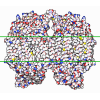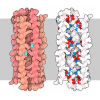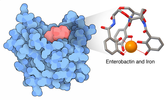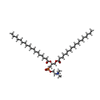+ Open data
Open data
- Basic information
Basic information
| Entry | Database: PDB / ID: 1ewf | ||||||
|---|---|---|---|---|---|---|---|
| Title | THE 1.7 ANGSTROM CRYSTAL STRUCTURE OF BPI | ||||||
 Components Components | BACTERICIDAL/PERMEABILITY-INCREASING PROTEIN | ||||||
 Keywords Keywords | ANTIBIOTIC / BACTERICIDAL / PERMEABILITY-INCREASING / LIPID-BINDING / LIPOPOLYSACCHARIDE-BINDING | ||||||
| Function / homology |  Function and homology information Function and homology informationnegative regulation of macrophage activation / Toll Like Receptor 4 (TLR4) Cascade / negative regulation of interleukin-8 production / Antimicrobial peptides / negative regulation of interleukin-6 production / negative regulation of tumor necrosis factor production / lipopolysaccharide-mediated signaling pathway / lipopolysaccharide binding / specific granule lumen / azurophil granule lumen ...negative regulation of macrophage activation / Toll Like Receptor 4 (TLR4) Cascade / negative regulation of interleukin-8 production / Antimicrobial peptides / negative regulation of interleukin-6 production / negative regulation of tumor necrosis factor production / lipopolysaccharide-mediated signaling pathway / lipopolysaccharide binding / specific granule lumen / azurophil granule lumen / defense response to Gram-negative bacterium / innate immune response / Neutrophil degranulation / extracellular space / extracellular exosome / extracellular region / membrane Similarity search - Function | ||||||
| Biological species |  Homo sapiens (human) Homo sapiens (human) | ||||||
| Method |  X-RAY DIFFRACTION / X-RAY DIFFRACTION /  SYNCHROTRON / Resolution: 1.7 Å SYNCHROTRON / Resolution: 1.7 Å | ||||||
 Authors Authors | Kleiger, G. / Beamer, L.J. / Grothe, R. / Mallick, P. / Eisenberg, D. | ||||||
 Citation Citation |  Journal: J.Mol.Biol. / Year: 2000 Journal: J.Mol.Biol. / Year: 2000Title: The 1.7 A crystal structure of BPI: a study of how two dissimilar amino acid sequences can adopt the same fold. Authors: Kleiger, G. / Beamer, L.J. / Grothe, R. / Mallick, P. / Eisenberg, D. #1:  Journal: Science / Year: 1997 Journal: Science / Year: 1997Title: Crystal Structure of Human BPI and Two Bound Phospholipids at 2.4 Angstrom Resolution Authors: Beamer, L.J. / Carroll, S.F. / Eisenberg, D. | ||||||
| History |
|
- Structure visualization
Structure visualization
| Structure viewer | Molecule:  Molmil Molmil Jmol/JSmol Jmol/JSmol |
|---|
- Downloads & links
Downloads & links
- Download
Download
| PDBx/mmCIF format |  1ewf.cif.gz 1ewf.cif.gz | 114.8 KB | Display |  PDBx/mmCIF format PDBx/mmCIF format |
|---|---|---|---|---|
| PDB format |  pdb1ewf.ent.gz pdb1ewf.ent.gz | 88.3 KB | Display |  PDB format PDB format |
| PDBx/mmJSON format |  1ewf.json.gz 1ewf.json.gz | Tree view |  PDBx/mmJSON format PDBx/mmJSON format | |
| Others |  Other downloads Other downloads |
-Validation report
| Summary document |  1ewf_validation.pdf.gz 1ewf_validation.pdf.gz | 866 KB | Display |  wwPDB validaton report wwPDB validaton report |
|---|---|---|---|---|
| Full document |  1ewf_full_validation.pdf.gz 1ewf_full_validation.pdf.gz | 881.1 KB | Display | |
| Data in XML |  1ewf_validation.xml.gz 1ewf_validation.xml.gz | 25.9 KB | Display | |
| Data in CIF |  1ewf_validation.cif.gz 1ewf_validation.cif.gz | 37.5 KB | Display | |
| Arichive directory |  https://data.pdbj.org/pub/pdb/validation_reports/ew/1ewf https://data.pdbj.org/pub/pdb/validation_reports/ew/1ewf ftp://data.pdbj.org/pub/pdb/validation_reports/ew/1ewf ftp://data.pdbj.org/pub/pdb/validation_reports/ew/1ewf | HTTPS FTP |
-Related structure data
| Related structure data | |
|---|---|
| Similar structure data |
- Links
Links
- Assembly
Assembly
| Deposited unit | 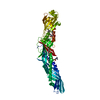
| ||||||||
|---|---|---|---|---|---|---|---|---|---|
| 1 |
| ||||||||
| Unit cell |
|
- Components
Components
| #1: Protein | Mass: 50703.625 Da / Num. of mol.: 1 / Mutation: S351A Source method: isolated from a genetically manipulated source Source: (gene. exp.)  Homo sapiens (human) Homo sapiens (human)Description: MAMMALIAN CHO CELLS USED FOR RECOMBINANT EXPRESSION OF THE PROTEIN Cell (production host): OVARY CELLS / Production host:  | ||||||
|---|---|---|---|---|---|---|---|
| #2: Chemical | | #3: Water | ChemComp-HOH / | Has protein modification | Y | Sequence details | A NATURALLY OCCURRING POLYMORPHISM EXISTS AT RESIDUE 185 FOR HUMAN BPI. THE CLONE USED FOR ...A NATURALLY OCCURRING POLYMORPHI | |
-Experimental details
-Experiment
| Experiment | Method:  X-RAY DIFFRACTION / Number of used crystals: 1 X-RAY DIFFRACTION / Number of used crystals: 1 |
|---|
- Sample preparation
Sample preparation
| Crystal | Density Matthews: 2.23 Å3/Da / Density % sol: 44.78 % | |||||||||||||||||||||||||
|---|---|---|---|---|---|---|---|---|---|---|---|---|---|---|---|---|---|---|---|---|---|---|---|---|---|---|
| Crystal grow | Temperature: 289 K / Method: vapor diffusion, hanging drop / pH: 6.8 Details: 12 % PEG 6000, 0.2 M Mg Acetate, 0.1 M Na Cacodylate, pH 6.8, VAPOR DIFFUSION, HANGING DROP, temperature 16K | |||||||||||||||||||||||||
| Crystal grow | *PLUS | |||||||||||||||||||||||||
| Components of the solutions | *PLUS
|
-Data collection
| Diffraction | Mean temperature: 93 K |
|---|---|
| Diffraction source | Source:  SYNCHROTRON / Site: SYNCHROTRON / Site:  NSLS NSLS  / Beamline: X12B / Wavelength: 0.975 / Beamline: X12B / Wavelength: 0.975 |
| Detector | Type: ADSC QUANTUM 4 / Detector: CCD / Date: Feb 6, 1998 |
| Radiation | Protocol: SINGLE WAVELENGTH / Monochromatic (M) / Laue (L): M / Scattering type: x-ray |
| Radiation wavelength | Wavelength: 0.975 Å / Relative weight: 1 |
| Reflection | Resolution: 1.7→100 Å / Num. all: 47198 / Num. obs: 47198 / % possible obs: 94.2 % / Observed criterion σ(F): -3 / Observed criterion σ(I): -3 / Redundancy: 2.3 % / Biso Wilson estimate: 24 Å2 / Rmerge(I) obs: 0.048 / Net I/σ(I): 16.7 |
| Reflection shell | Resolution: 1.7→1.76 Å / Redundancy: 1.3 % / Rmerge(I) obs: 0.201 / Num. unique all: 3300 / % possible all: 67 |
| Reflection shell | *PLUS % possible obs: 67 % |
- Processing
Processing
| Software |
| |||||||||||||||||||||||||
|---|---|---|---|---|---|---|---|---|---|---|---|---|---|---|---|---|---|---|---|---|---|---|---|---|---|---|
| Refinement | Resolution: 1.7→50 Å / σ(F): 0 / σ(I): 0 / Stereochemistry target values: Engh & Huber
| |||||||||||||||||||||||||
| Refinement step | Cycle: LAST / Resolution: 1.7→50 Å
| |||||||||||||||||||||||||
| Refine LS restraints |
| |||||||||||||||||||||||||
| Software | *PLUS Name: 'CNS' / Classification: refinement | |||||||||||||||||||||||||
| Refine LS restraints | *PLUS
|
 Movie
Movie Controller
Controller




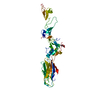
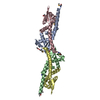

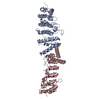
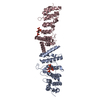
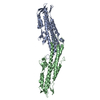
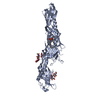
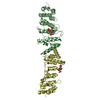

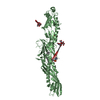
 PDBj
PDBj

